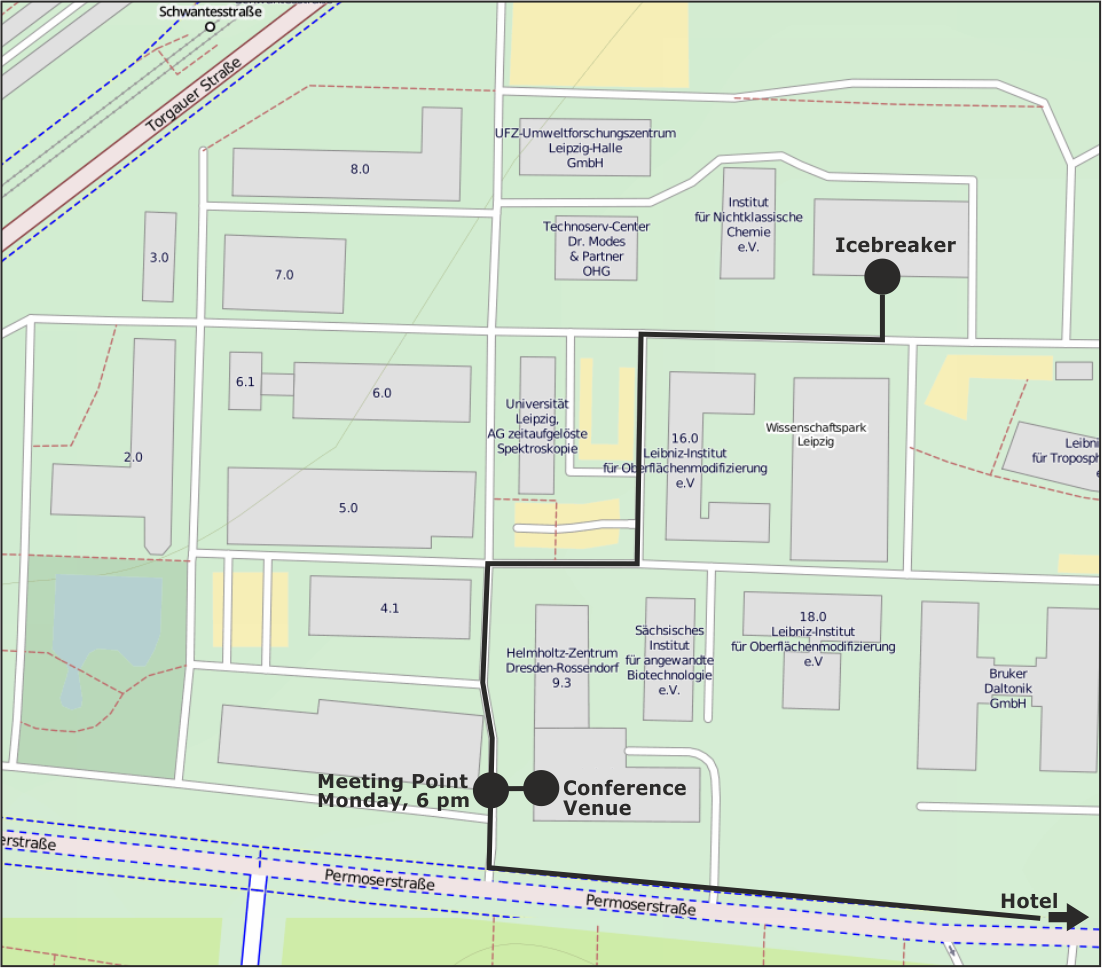Schedule (preliminary)
Monday
| Icebreaker | ||
| 18–21 | BBQ, Drinks and Cosmic Rays | |
Tuesday
| 9:00 | Cosmic Ray Refresher (64 MB) | M. Schrön |
| Present and Future State of COSMOS | ||
| 9:30 | TERENO – a network for integrated environmental research | S. Zacharias |
| 10:00 | COSMOS-USA and Global Outlook | M. Zreda |
| 10:30 | COSMOS-UK: First Results and Future Plans | J. Evans |
| 11:00 | – Break – | |
| 11:15 | Development of a Cosmic Ray Probe Network in South Africa | C.S. Everson |
| 11:45 | Outlook for CRS project in China | S. Zia |
| 12:00 | CosmOz: Status in Australia | R. Silberstein |
| 12:30 | – Break – | |
| Calibration & Validation | ||
| 13:30 | COSMOS-UK Spatial Sampling Strategy | R. Morrison |
| 14:00 | Calibration of COSMOS probes: Results from a comparison study | H. Bogena |
| 14:30 | Field testing of the universal calibration function for determination of soil moisture with cosmic-ray neutrons | T. Franz |
| 15:00 | – Break – | |
| 15:15 | Comparability of co-located Cosmic-Ray Sensors | M. Schrön | 15:45 | Comparing scales of measurement of soil moisture and evaporation with micrometeorology and COSMOS | T. Denmead |
| 16:15 | Calibration and downscaling of seasonal soil moisture forecasts using satellite data | S. Schneider |
| 16:45 | Recent progress and novel use of COSMOS probes | M. Zreda |
| 17:15 | – Discussion – | |
| Dinner | ||
| 19–22 | Bayerischer Bahnhof Leipzig | |
Wednesday
| Soil Moisture | ||
| 9:00 | CRS in a highly-instrumented small catchment - the Schäfertal Site | S. Oswald |
| 9:30 | Cosmic Ray Neutron Probe Soil Water Measurements over Complex Terrain in Austria | A. Wahbi |
| 10:00 | CRS in irrigated citrus orchard in Morocco | K. Mroos |
| 10:30 | Measurement of soil moisture with cosmic-ray neutrons in deciduous forests | I. Heidbüchel |
| 11:00 | – Break – | |
| Biomass | ||
| 11:15 | Empirical Impacts of Biomass on Soil Moisture Quantification by Cosmic-Ray Probes | R. Baatz |
| 11:45 | Cosmic ray neutron sensing in cropped field: challenges and progress. | G. Baroni |
| 12:15 | Is it possible to detect the biomass and intercepted water of a forest using measurements of cosmic-ray neutron intensity? | M. Andreasen |
| 12:45 | – Break – | |
| Ecosystem States & Fluxes | ||
| 13:45 | A deeper understanding of ecosystem function using cosmic-ray neutrons | T. Franz |
| 14:15 | Use of CosmOz to inform estimation of recharge to an unconfined groundwater system | R. Silberstein |
| 14:45 | The impact of observed cosmic-ray neutrons on simulated soil moisture and land energy partitioning | R. Rosolem |
| 15:15 | – Break – | |
| Neutron Transport and Detection | ||
| 15:30 | Spatial variability of cosmic-ray intensity and the two big factors for rover surveys | D. Desilets |
| 16:00 | Empirical and Theoretical Determination of the Horizontal Footprint | M. Zreda |
| 16:30 | Neutron Detection Methods | A. Hendriks |
| 17:00 | Detector Sensitivity to Cosmic Ray induced Neutrons | M. Köhli |
| 17:30 | – Final Discussion and Summary – | |
Thursday
| Optional Fieldtrip | ||
|
"TERENO catchment Schäfertal and the research station Bad Lauchstädt" In a small catchment (1.44 km2) within the Harz mountains water and matter fluxes are explored at multiple scales using Lysimeters, soil-moisture networks and cosmic ray probes. This is combined with the exploration of subsurface structures using geophysical tools, remote sensing and soil-landscape modeling. On the way back the UFZ Research Station in Bad Lauchstädt is visited where among others the TERENO SoilCan projects and the "Global Change Experimental Facility" — a large infrastructure for climate manipulation experiments — is presented. | ||
| 9–11 | Trip to the Schäfertal catchment | |
| 11–13 | Schäfertal site: demonstration and presentation | |
| 13–14 | Trip to Bad Lauchstädt (GCEF) | |
| 14–15 | GCEF site: demonstration and presentation | |
| 15–16 | Trip to Leipzig | |



